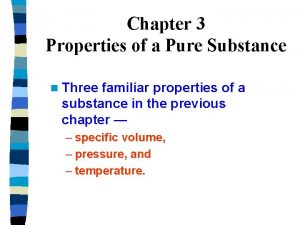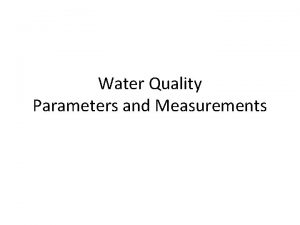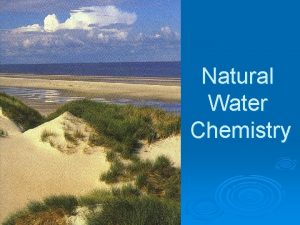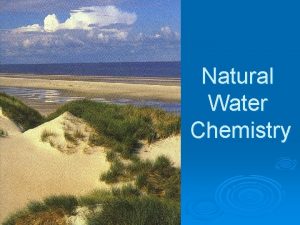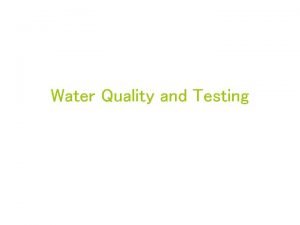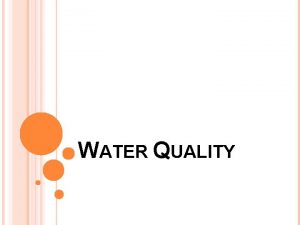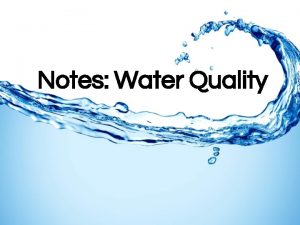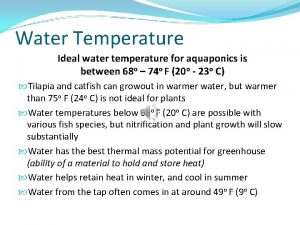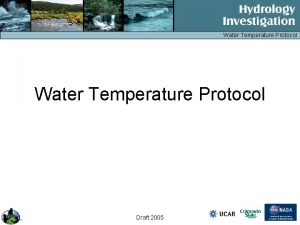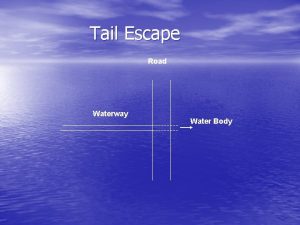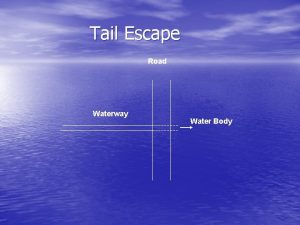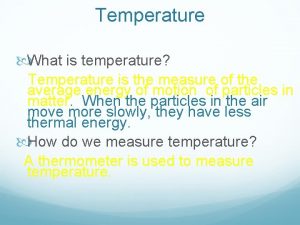WATER QUALITY PARAMETERS TEMPERATURE Temperature of a waterway





















- Slides: 21

WATER QUALITY PARAMETERS

TEMPERATURE � Temperature of a waterway is significant because it affects the amount of dissolved oxygen in the water. � The amount of oxygen that will dissolve in water increases as temperature decreases. � Water at O C will hold up to 14. 6 mg/l of oxygen, while at 30 C it will hold only up to 7. 6 mg/L.

TEMPERATURE � Temperature also affects, � the metabolic rate of aquatic animals, � rates of development, � Rate of reproduction, and � the sensitivity of organisms to toxins, parasites and disease. � Temperature ranges for plants and animals can be affected by manmade structures such as dams and weirs and releases of water from them.

How Water Temperature Increases? � It happens Due to � summer season, � Industry effluents and run off, � Deforestation, � Turbidity in water, � Algae growth.

SALINITY � A measure of the dissolved salts in the water. � measured as either TDS (Total Dissolved Solids), which measures the amount of dissolved salts in the water, � or as EC (Electrical Conductivity), which is the property of a substance which enables it to serve as a channel or medium for electricity. � Saline water is good conductor of electricity. � EC can be converted to TDS and vice versa.

SOURCES OF SALINITY � include � urban and rural run-off containing salt, � fertilisers and � Organic matter. � Land use issues related to high levels of salinity include � the resultant rise in the water table, excessive irrigation, groundwater seepage and runoff containing dissolved solids from industry, sewage, agriculture etc.

EFFECTS OF SALINITY � salinity that is beyond the normal range for any species of organism will cause health problems or even death to that organism. � Water containing a TDS level of over 500 mg/L is unsuitable for irrigation of many plants and tastes unpleasant to drink.

TURBIDITY � Turbidity is a measure of the ability of light to pass through water, that is, a measure of the water’s cloudiness. � Measuring cloudiness gives an estimate of suspended solids in the water. � Turbidity is measured in Nephelometric Turbidity Units (NTU’s).

HOW DO TURBIDITY LEVELS RISE? � Higher turbidity can be caused by human activity like cutting trees and removing vegetation next to a body of water. � Trees provide shade to keep the water cooler, and trees and other plants help block mud and soil from washing into the water.

TURBIDITY EFFECTS � High turbidity affects submerged plants by preventing sufficient light from reaching them for photosynthesis. � High turbidity also has the capacity to significantly increase water temperature. � Though high turbidity is often a sign of poor water quality and land management, crystal clear water does not always guarantee healthy water. � Extremely clear water can signify very acidic conditions or high levels of salinity.

p. H � At extremely high or low p. H levels, the water becomes unsuitable for most organisms. � Young fish and insects are also very sensitive to changes in p. H. � Most aquatic organisms adapt to a specific p. H level and may die if the p. H of the water changes even slightly.

p. H � p. H can vary from its normal levels (6. 5 to 8. 2) due to pollution from automobiles and coal-burning power plants. � These sources of pollution help to form acid rain. � Acid forms when chemicals in the air combine with moisture in the atmosphere. � It falls to earth as acid rain or snow. � A ph range of 6. 5 – 8 is optimal for freshwater. � A range of 8 – 9 is optimal for sea water.

DISSOLVED OXYGEN (DO) � The amount of oxygen in water, to a degree, shows its overall health. � That is, if oxygen levels are high, one can guess that pollution levels in the water are low. � Conversely, the body of water is not of optimal health.

BIOCHEMICAL OXYGEN DEMAND (BOD) � When organic matter decomposes, microorganisms (such as bacteria and fungi) feed upon this decaying material and eventually the matter becomes oxidized. � Biochemical oxygen demand, or BOD, measures the amount of oxygen consumed by microorganisms in the process of decomposing organic matter in stream water. � The harder the microorganisms work, the more oxygen they use, and the higher the measure of BOD, leaving less oxygen for other life in the water.

BOD EFFECTS �A high BOD measure harms stream health in the same ways as low dissolved oxygen: aquatic organisms become stressed, suffocate, and die. � The few organisms that can survive with less oxygen, like carp and sewage worms, will increase in number.

HOW DO BOD LEVELS RISE? � As more organic matter enters a stream, the BOD will rise. � Organic � leaves matter may include and woody debris; � dead plants and animals; � animal manure; � effluents from mills, � and food-processing plants; etc.

WATER HARDNESS � � Water hardness in the water is of two types, 1. Permanent water hardness is attributed to the presence of sulfates and chlorides of calcium and magnesium. � The permanent hardness can only be removed by chemical means. � 2. Temporary water hardness is attributed to the presence of bicarbonates of calcium and magnesium. � The temporary hardness can be removed by boiling the water.

NITROGEN AND PHOSPHOROUS � Phosphorus/Nitrogen enters the water � Plants take up them and grow too much � Plants (algae) die and sink to the bottom � Bacteria at the bottom decompose the dead plants, using up oxygen in the process � Oxygen levels drop, killing fish or aquatic insects � They both continues to enter the water � The cycle continues

OIL AND GREASE � This includes all oils, fats and waxes, such as kerosene and lubricating oils. � Oil and grease causes unsightly films on open water bodies and negatively affects aquatic life. � It forms a layer on surface of water and does not allow the oxygen to be dissolved in water. � It also blocks sewerage lines and pipes and results in blockage of waste water disposal and treatment.

COLOR IN WATER � algae may impart a green, brown or even reddish color to the water. � Red and brown colors are due to iron; � black � and is due to manganese or organic matter; yellow to dissolved organic matter.

REFERENCES � WATER QUALITY PARAMETERS & INDICATORS � Water Quality Parameters � http: //greenactivist. wordpress. com/2012/02/29/ water-quality-parameters/
 Cactus hill virginia artifacts
Cactus hill virginia artifacts Trent-severn waterway national historic site
Trent-severn waterway national historic siteFlorida inland waterway
 Types of waterway
Types of waterway 5 major peninsulas of europe
5 major peninsulas of europe Water and water and water water
Water and water and water water Difference between curie temperature and neel temperature
Difference between curie temperature and neel temperature Difference between curie temperature and neel temperature
Difference between curie temperature and neel temperature Ferromagneti
Ferromagneti Quality control and quality assurance
Quality control and quality assurance Plan quality management pmp
Plan quality management pmp Pmbok quality management
Pmbok quality management Quality assurance model in nursing
Quality assurance model in nursing Compliance vs quality
Compliance vs quality Quality assurance concepts
Quality assurance concepts Which of the gurus would be the father of quality control?
Which of the gurus would be the father of quality control? Quality is free
Quality is free Old quality vs new quality
Old quality vs new quality Torch lake water temperature
Torch lake water temperature Benzoylation reaction of amines
Benzoylation reaction of amines Pure substance examples
Pure substance examples Chapter 21 temperature heat and expansion answer key
Chapter 21 temperature heat and expansion answer key



















